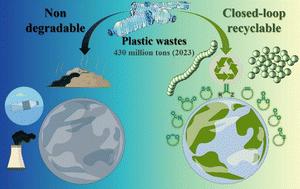当前位置:
X-MOL 学术
›
Chem. Soc. Rev.
›
论文详情
Our official English website, www.x-mol.net, welcomes your feedback! (Note: you will need to create a separate account there.)
Closed-loop recyclable polymers: from monomer and polymer design to the polymerization–depolymerization cycle
Chemical Society Reviews ( IF 40.4 ) Pub Date : 2024-08-23 , DOI: 10.1039/d4cs00663a Shuaiqi Yang, Shuai Du, Jin Zhu, Songqi Ma
Chemical Society Reviews ( IF 40.4 ) Pub Date : 2024-08-23 , DOI: 10.1039/d4cs00663a Shuaiqi Yang, Shuai Du, Jin Zhu, Songqi Ma

|
The extensive utilization of plastic, as a symbol of modern technological society, has consumed enormous amounts of finite and non-renewable fossil resources and produced huge amounts of plastic wastes in the land or ocean, and thus recycling and reuse of the plastic wastes have great ecological and economic benefits. Closed-loop recyclable polymers with inherent recyclability can be readily depolymerized into monomers with high selectivity and purity and repolymerized into polymers with the same performance. They are deemed to be the next generation of recyclable polymers and have captured great and increasing attention from academia and industry. Herein, we provide an overview of readily closed-loop recyclable polymers based on monomer and polymer design and no-other-reactant-involved reversible ring-opening and addition polymerization reactions. The state-of-the-art of circular polymers is separately summarized and discussed based on different monomers, including lactones, thiolactones, cyclic carbonates, hindered olefins, cycloolefins, thermally labile olefin comonomers, cyclic disulfides, cyclic (dithio) acetals, lactams, Diels–Alder addition monomers, Michael addition monomers, anhydride–secondary amide monomers, and cyclic anhydride–aldehyde monomers, and polymers with activatable end groups. The polymerization and depolymerization mechanisms are clearly disclosed, and the evolution of the monomer structure, the polymerization and depolymerization conditions, the corresponding polymerization yield, molecular weight, performance of the polymers, monomer recovery, and depolymerization equipment are also systematically summarized and discussed. Furthermore, the challenges and future prospects are also highlighted.
中文翻译:

闭环可回收聚合物:从单体和聚合物设计到聚合-解聚循环
塑料的广泛利用,作为现代科技社会的标志,消耗了大量有限且不可再生的化石资源,并在陆地或海洋中产生了大量的塑料垃圾,因此塑料垃圾的回收和再利用具有重大意义。生态效益和经济效益。具有固有可回收性的闭环可回收聚合物可以很容易地解聚成具有高选择性和纯度的单体,并重新聚合成具有相同性能的聚合物。它们被认为是下一代可回收聚合物,并引起了学术界和工业界越来越多的关注。在此,我们概述了基于单体和聚合物设计以及不涉及其他反应物的可逆开环和加成聚合反应的易于闭环可回收聚合物。基于不同单体,包括内酯、硫代内酯、环状碳酸酯、受阻烯烃、环烯烃、热不稳定烯烃共聚单体、环状二硫化物、环状(二硫代)缩醛、内酰胺、狄尔斯-阿尔德加成单体、迈克尔加成单体、酸酐-仲酰胺单体、环状酸酐-醛单体以及具有可活化端基的聚合物。清晰地揭示了聚合和解聚机理,并对单体结构的演变、聚合和解聚条件、相应的聚合产率、分子量、聚合物的性能、单体回收和解聚设备进行了系统的总结和讨论。此外,还强调了挑战和未来前景。
更新日期:2024-08-23
中文翻译:

闭环可回收聚合物:从单体和聚合物设计到聚合-解聚循环
塑料的广泛利用,作为现代科技社会的标志,消耗了大量有限且不可再生的化石资源,并在陆地或海洋中产生了大量的塑料垃圾,因此塑料垃圾的回收和再利用具有重大意义。生态效益和经济效益。具有固有可回收性的闭环可回收聚合物可以很容易地解聚成具有高选择性和纯度的单体,并重新聚合成具有相同性能的聚合物。它们被认为是下一代可回收聚合物,并引起了学术界和工业界越来越多的关注。在此,我们概述了基于单体和聚合物设计以及不涉及其他反应物的可逆开环和加成聚合反应的易于闭环可回收聚合物。基于不同单体,包括内酯、硫代内酯、环状碳酸酯、受阻烯烃、环烯烃、热不稳定烯烃共聚单体、环状二硫化物、环状(二硫代)缩醛、内酰胺、狄尔斯-阿尔德加成单体、迈克尔加成单体、酸酐-仲酰胺单体、环状酸酐-醛单体以及具有可活化端基的聚合物。清晰地揭示了聚合和解聚机理,并对单体结构的演变、聚合和解聚条件、相应的聚合产率、分子量、聚合物的性能、单体回收和解聚设备进行了系统的总结和讨论。此外,还强调了挑战和未来前景。
















































 京公网安备 11010802027423号
京公网安备 11010802027423号